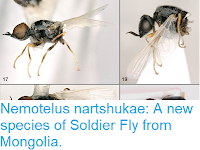The Tephritidae is a relatively recently diverged Fruit Fly family that might have arisen around the Late Eocene (around 36 million years ago). Currently, this family includes approximately 4700 valid species under about 500 genera, seven of which are species-rich (i.e. having over 100 species). These highly diverged genera are notorious for harbouring a number of species complexes that are taxonomically difficult to deal with. Campiglossa is one of those species-rich genera, and is estimated to have approximately 200 described species. Campiglossa is a predominantly Palaearctic genus but a significant number of representative species occur in all the other zoogeographical regions. The majority of species of known biology are associated with the capitula (dense flat clusters of small flowers) of composite plants (family Asteraceae). Due to their high intra-specific variation, low inter-specific variation, sexual dimorphism and seasonal variation, systematic investigation of Campiglossa is considered very difficult. Examination of their male and female postabdominal structure has been somewhat helpful for defining species and species groups. Obtaining host associated specimens has also been useful for understanding their intra- and interspecific variation. Most recently, DNA barcoding has proven useful for identifying tephritid species and species groups, as well as confirming generic limits.
In a paper published in the journal ZooKeys on 12 December 2019, Ho-Yeon Han and Kyung-Eui Ro of the Division of Biological Science and Technology at Yonsei University describe a new species of Campiglossa from Korea and Russia, discovered in the process of analyzing DNA barcodes of all the Korean and some East Asian Tephritid Fruit Fly species.
The new species is named Campiglossa paramelaena, meaning 'beside melaena' in reference to the fact that it is closely related to Campiglossa melaena. The species is described from nine specimens, one male from Mt. Cheongnyangsan in Gyeongsangbuk-do (North Gyeongsangbuk) Province in South Korea, three male and three female specimens from Kedrovaya Pad in the Khasansky District of Primorsky Krai (Primorsky State) in the Russian Far East, one male from Barabash, also in Khasansky District, and one female from Ussuriysk, again in Khasansky District.
(A)–(E) Campiglossa paramelaena. (A) Male, lateral view, (B) male, dorsal view, (C) male wing, (D) female, lateral view, (E) female, dorsal view, (F) female, wing. (G)–(K) Campiglossa melaena. (G) Male, lateral view, (H) male, dorsal view, (I) male, wing, (J) male, wing, (K) female, wing.
The head of Campiglossa paramelaena is largely yellowish brown with a grey upper occiput (back of the head). The scutum (middle upper part of the thorax) entirely ash-grey with five faint brownish longitudinal stripes, the scutellum (posterior upper part of the thorax) is ash-grey with a yellowish-brown apex; the rest of the thorax is dark brown. The femora (upper parts) of the legs are dark grey except for yellowish brown apices, the tibiae and tarsi (lower parts) are yellowish brown. The Abdomen is ash-grey with paired brown submedian spots. The wings are glassy with dark spots.
See also...
See also...
Follow Sciency Thoughts on Facebook.







